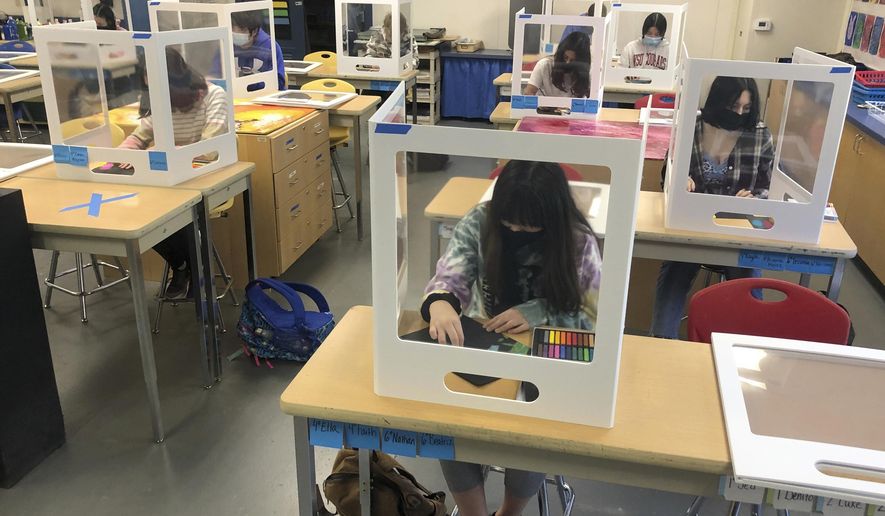Teachers’ unions are under scrutiny in the wake of a Harvard study that shows racial and economic achievement gaps widened during the COVID-19 virtual-learning lockdowns supported by the labor groups.
Harvard University’s report on testing data from 2.1 million students in 10,000 schools found that high-poverty, multicultural public schools spent more weeks in remote instruction during 2020-21 and suffered bigger declines in scores. By contrast, low-poverty districts that remained largely in-person lost relatively little ground.
Thomas Kane, a Harvard economics and education professor who directed the study, said the poor schools that stayed remote for more than half of 2021 lost “about half of a school year’s worth of typical achievement growth.”
“The striking and important finding was that remote instruction had much more negative impacts in high-poverty schools. High-poverty schools were more likely to go remote and their students lost more when they did so,” Mr. Kane told the Harvard Gazette on Thursday.
The Harvard study found that math learning gaps did not significantly widen between affluent and impoverished schools in districts that returned to in-person learning more quickly.
Citing the study, conservatives are calling on teachers’ unions to own the consequences of their decision to extend virtual and hybrid learning longer than many parents felt necessary.
“Unfortunately, the teachers’ unions opposed in-person learning throughout the pandemic, even after ample data confirming that COVID-19 posed little to no risk to children and that children are not vectors for transmission,” said Chris Talgo, a research fellow at the conservative Heartland Institute in Illinois.
The former U.S. history and government teacher added that poor students suffered from the unions’ “conflict of interest” in working with the federal government to prolong school lockdowns that educators publicly disowned.
Teachers’ unions in California, Illinois and Minnesota extended school lockdowns as recently as two months ago by going on strike for better mental health support and higher pay. They cited pandemic-related burnout among their reasons for refusing to teach in person.
Ashley N. Varner, vice president of communications and federal affairs at the Freedom Foundation, an anti-union advocacy group, said the Harvard study confirms that poorer students lacked the resources to learn from home while teachers shifted into cruise control.
“Their parents couldn’t afford to supplement the education they were missing at school and some kids didn’t even have internet at home to participate in Zoom school,” Ms. Varner said in an email.
The National Education Association, the nation’s largest teachers’ union, did not respond on Wednesday to a request for comment.
The American Federation of Teachers (AFT), which consulted on February guidelines from the Centers for Disease Control and Prevention that allowed many schools to remain closed this spring, said it has “worked with parents and the community to safely reopen schools and other institutions vital to the nation’s social and economic health since the first months of the pandemic.”
“Even before COVID-19, educators knew that remote education, relentlessly championed and invested in by [Trump administration Education Secretary] Betsy DeVos, was only a supplement, not a substitute, for in-person learning,” an AFT spokesperson said in an emailed statement.
Phil Magness, director of research and education at the libertarian American Institute for Economic Research in Massachusetts, said union leaders offered these comments as political cover for the unpopular decision to keep campuses closed.
“Some such as the AFT’s Randi Weingarten are desperately trying to reinvent their histories, despite spending much of 2020-21 resisting efforts to reopen K-12 education,” Mr. Magness said in an email.
Efforts to avoid responsibility for school lockdowns have intensified in recent months, as most U.S. schools reopened with the decline of COVID-19 infections.
According to Burbio’s online K-12 School Opening Tracker, the number of schools with weekly disruptions of in-person learning declined from 7,463 on Jan. 10 to 97 on May 2.
As of Wednesday, Burbio also reported that 486 school districts no longer require face masks, compared to nine districts that still have mask mandates and five that have partial masking rules.
Early retirements meanwhile have driven a national shortage of teachers and staff, forcing some districts to shorten their instructional weeks.
Quisha King, senior director of education at the conservative Moms for America, said many teachers had “irrational fears” of catching COVID-19 from their students.
“The fears caused teachers not to want to teach and to be compensated to not teach,” Ms. King said.
Sean Higgins, a research associate at the libertarian Competitive Enterprise Institute, said these fears played out in extended contract negotiations last year.
He cited a study from the liberal Brookings Institution last year that found the longer a school negotiated its collective bargaining agreement, the less likely it was to reopen with in-person instruction and the more likely to rely on distance learning.
“Teachers’ unions like to claim that what is good for their members is good for students, but parents are increasingly realizing that that isn’t always the case,” Mr. Higgins said.
Last week’s Harvard study on “The Consequences of Remote and Hybrid Instruction During the Pandemic” also found fewer achievement gaps between rich and poor schools in states like Texas and Florida, which reopened earlier for in-person learning.
Christina Pushaw, press secretary for Florida Gov. Ron DeSantis, said the state’s public schools have been “fully reopened for in-person education” since fall 2020.
“We welcome the broadcasting of this data that supports this commonsense position, although we wish this had been acknowledged by Harvard a year ago,” Ms. Pushaw told The Times in an email.
“Kids in lockdown cities and states were unjustly forced to wait another year to return to normal full-time in-person learning,” she added.
For more information, visit The Washington Times COVID-19 resource page.
• Sean Salai can be reached at ssalai@washingtontimes.com.




Please read our comment policy before commenting.